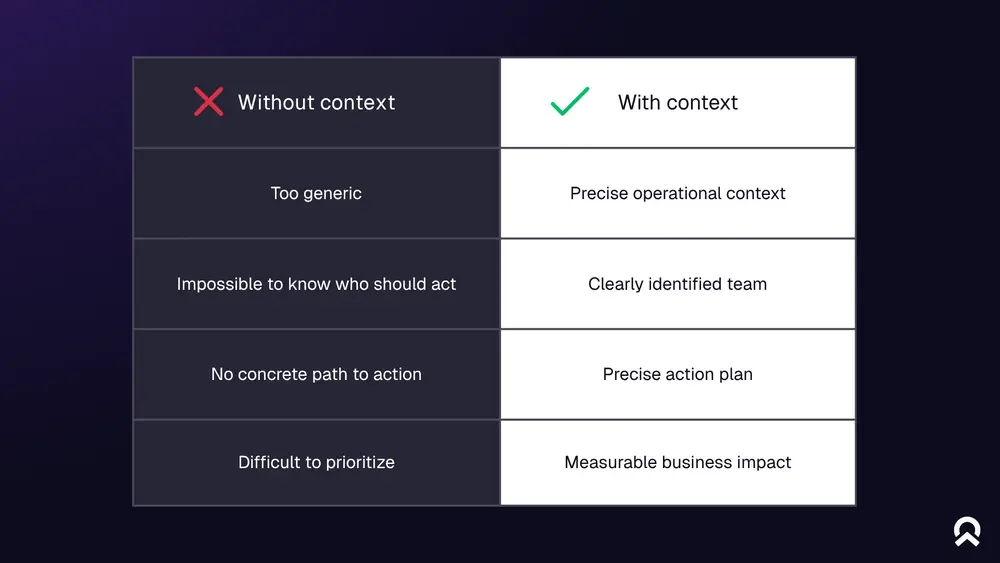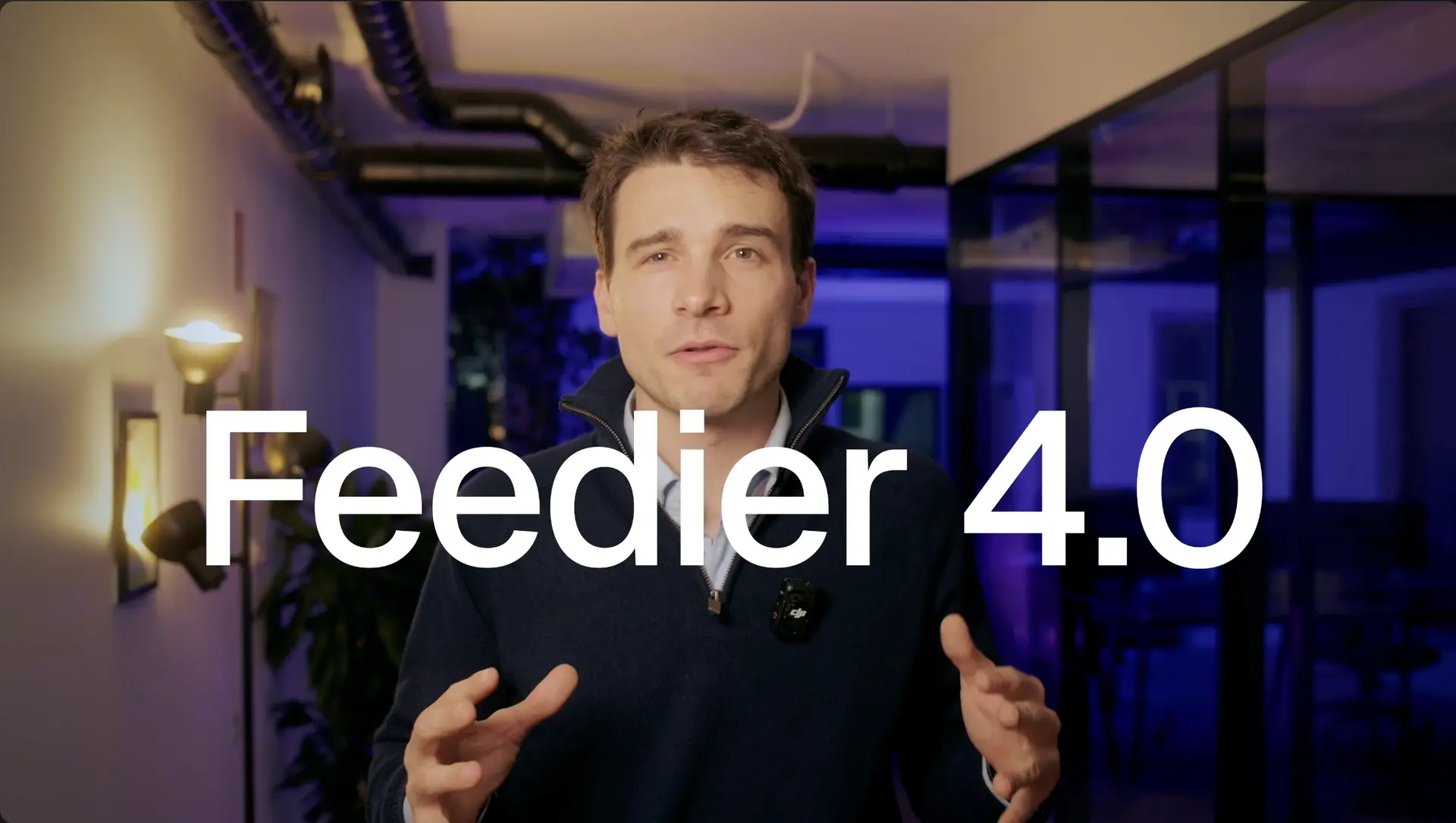
Qualifying, Contextualizing, and Measuring Weak Signals in Customer Feedback

Most organizations receive dozens, sometimes hundreds, of pieces of customer feedback every day. From surveys and reviews to support tickets and social media messages, the sources are multiplying and the volumes are growing. Yet, few companies manage to turn this feedback into concrete decisions.
The problem is no longer collection, but analysis. It’s not a lack of feedback, but a lack of a clear method to extract what truly matters. Because hidden within this data are weak signals, rare but revealing insights that can foreshadow a strategic issue, an opportunity for improvement, or a serious churn risk.
That is precisely the purpose of this article: to provide a three-step method for identifying these weak signals, connecting them to your operational context, and measuring their impact. This approach is designed to help CX teams move beyond simply listening to the Voice of the Customer and start acting with clarity and purpose.
Qualifying weak signals in customer feedback
Qualifying a weak signal means telling the difference between simple "noise" and information that deserves your attention. It's the essential first step to focusing your efforts where they will have a real impact.
What a weak signal is (and isn't)
A weak signal is not defined by its frequency, but by its strategic potential. It is discreet information that, when interpreted correctly, can signal an underlying trend, a risk, or an opportunity. To better understand it, it's helpful to compare it to "noise."
A weak signal is:
- A comment that addresses an entirely new topic.
- A very strong emotion (frustration, disappointment, but also delight) expressed by a customer, even if it's an isolated case.
- Feedback that, while rare, touches on a critical moment in your customer journey (e.g., the first time using a product).
It is not:
- A simple, non-constructive rant.
- A highly specific request that concerns only a single user without any broader impact.
- A known and tracked issue, which is a strong signal, not a weak one.
How to identify the signals that truly matter
To move from theory to practice, the value of feedback first depends on its source. A review from a high-value customer, a new user of a flagship product, or a key partner does not carry the same weight as an anonymous comment. In the analysis of weak signals, the "who" is often more important than the "how many."
Next, a relevant signal is one that reveals a hidden friction point. Some feedback highlights an irritant that your standard performance indicators, like NPS or CSAT, cannot detect. A customer who explains in detail why they can't use a feature gives you much more actionable information than a simple satisfaction score.
Finally, you must be attentive to signals that announce an unmet need. Sometimes, a customer will describe a creative or unintended use of your product. Far from being anecdotal, this behavior is often the symptom of a latent need, that is, a real but not yet expressed need from the customer, that your current offer does not cover. Identifying these "workarounds" can open up particularly fertile paths for innovation.
3 Common mistakes to avoid in your analysis
In the hunt for weak signals, certain pitfalls are common. Avoiding them will save you time and improve your relevance.
- Mistake #1 - Relying solely on volume: The biggest mistake is to think that if a topic isn't mentioned dozens of times, it isn't important. The opposite is true: major opportunities and risks often begin with a few isolated pieces of feedback. Don't let quantity hide quality.
- Mistake #2 - Neglecting unstructured data: The most valuable signals are rarely hidden in 0-to-10 ratings. They are in the open-text fields of surveys, emails sent to support, or comments on social media. It is in these unfiltered spaces for expression that true insights appear.
- Mistake #3 - Thinking in silos: A comment about a delivery problem may seem anecdotal. But if, in the same month, customer service receives calls about the same topic and a Google review mentions it, the weak signal is becoming the start of a trend. It is crucial to centralize feedback to connect the dots.
Contextualizing weak signals with business data
A qualified weak signal is an alert. A contextualized weak signal is an action plan in the making. This crucial step involves connecting each piece of feedback to your operational reality to reveal its meaning, urgency, and ownership. This is where listening transforms into intelligence.
The Game-Changing example: from raw verbatim to actionable insight
The power of context is best demonstrated through an example. Take this piece of customer feedback, which is typical of what CX teams receive:
Raw feedback (without context):
"The claim form is too complex, I gave up."
This feedback is frustrating. It signals a problem but offers no leads: which form? For what type of customer? Is the impact marginal or critical?
Now, let's enrich this same feedback with business data:
Contextualized insight:
"A 'Large Account' segment client (+€100k ARR), following an incident with our 'Premium' offer, tried to fill out the claim form on their mobile browser (Safari on iOS). They found it too complex and gave up to call their account manager directly, thereby mobilizing a costly resource for a task that should have been self-service."
The context immediately answers three vital questions:
- What's the urgency?
High. The irritant affects a strategic client and impacts the perception of a premium offer. - Who needs to act?
The Product team (for the form) and the front-end development team (for the mobile experience). The CSM manager should also be informed. - What's the business impact?
A poor experience at a sensitive touchpoint (the claim), an unnecessary operational cost (the call to the CSM), and a risk to the satisfaction of a major client.

The 4 Key Dimensions for 360° Context
Contextualization isn't an art; it's a method. It relies on systematically crossing each piece of feedback with at least four major families of data.
1 - The "Customer" Dimension: Who is the source of the feedback?
It is essential to connect the feedback to your CRM data. This allows you to answer specific questions that determine priority: does the customer belong to a strategic segment? Do they have a high customer lifetime value (CLV)? Are they in a critical phase of their lifecycle (e.g., the first month of use)? A bug reported by a user on a free trial will never have the same urgency as the same bug reported by your longest-standing customer.
2 - The "Product/Service" Dimension: What exactly are we talking about?
Feedback must be linked to the specific item it concerns. Is it your flagship product or a secondary feature? A B2B or B2C offer? A particular service? This connection not only helps to direct the information to the right product manager but also to group feedback to identify if a specific part of your offer is a focal point for irritants.
3 - The "Journey" Dimension: At what point does the problem occur?
Timing is a fundamental clue. Was the feedback given during the discovery phase, right after a purchase, during an interaction with support, or at the time of renewal? Knowing when a customer expresses friction helps you map out the weak points of your overall experience and understand if the problem is related to acquisition, onboarding, usage, or retention.
4 - The "Source" Dimension: Where does the information come from?
A weak signal is often information that appears on multiple channels simultaneously. A problem can be mentioned in an NPS survey, a support ticket, and a Google review in the same week. Without a centralized view that connects these sources, each piece of feedback will remain an isolated point. Crossing sources transforms scattered weak signals into a clear and quantifiable trend. It is particularly by leveraging specific technologies that it becomes possible to detect weak signals with AI across the entire customer journey.
What really happens when context is missing
Ignoring contextualization is not a simple oversight; it's a strategic mistake that creates hidden costs and weakens your organization.
Imagine this scenario: your development team spends two days fixing a minor bug reported by a single, non-strategic user. Meanwhile, a performance issue with your new offer, discreetly reported by three of your largest customers via their sales reps, is not addressed because the information was not centralized and enriched. The cost is not just the lost development time; it's the churn risk you didn't see coming.
Worse still, a CX team that forwards raw verbatims is quickly perceived as a passive "mailbox" with no added value. Other departments develop "feedback fatigue" and eventually start ignoring the alerts. Conversely, a contextualized insight, such as "We've seen a 15% increase in tickets related to 'connection problems' for iOS users since update 3.2," is a contribution that commands attention and positions the CX team as an indispensable strategic partner.
Measuring the impact of weak signals
A qualified and contextualized insight is knowledge. A measured insight is a catalyst for decision-making. This final step involves giving your analysis business weight to turn a customer problem into a company priority.
Quantifying the cost of inaction
For a topic to be addressed, it must speak the language of business: numbers. Before any presentation, estimate the financial impact of each important weak signal by answering these key questions:
- What revenue is at risk?
Calculate the annual value of the customer accounts directly affected by the irritant. - What are the hidden operational costs?
Evaluate the support time, refunds, or goodwill gestures related to the problem. - What is the churn risk?
Model the potential customer loss by applying a risk factor to the affected segment. - What growth opportunity is being missed?
If the signal is an idea, estimate the potential gain if it were developed.
The priority matrix: a formula for objectivity
To compare problems of different natures, use a simple formula that scores the impact of each insight. This helps create a clear and defensible hierarchy.
Impact Score = Scope x Severity x Criticality
- Scope (quantitative): Does the problem affect many customers? Does it concern a significant amount of revenue?
- Severity (qualitative): Is it a simple irritant, a major obstacle that causes frustration, or a total blocker that prevents use of the service?
- Criticality (strategic): Is the problem directly linked to a key company objective (e.g., reducing churn, increasing adoption)?
A problem with low scope but very high severity and criticality can thus become a higher priority than a widespread irritant with no real strategic impact.
Convincing internally: one message, two audiences
Measuring impact is useless if the message is not communicated effectively. The key is to radically adapt your discourse to your audience.
- For Leadership: Be concise and speak "business."
Present a summary focused on financial indicators: revenue at risk, the cost of inaction, and the return on investment of the solution. Use key figures and one or two impactful verbatims from important customers to justify your request for resources. The goal: to get a decision. - For Operational Teams: Be precise and speak "solution."
Provide a factual and actionable brief: the context of the problem's appearance, quantified data (number of tickets, affected segments), and qualitative examples (verbatims, logs) that will help them diagnose and act effectively. The goal: to empower them to solve it.
Conclusion
Faced with a constant volume of customer feedback, the solution is not to listen to everything, but to know what to do with what you hear. Analysis without action is a cost; listening without a decision is sterile noise. A truly useful piece of feedback is therefore not raw or isolated: it is qualified for its relevance, contextualized to be understood by the right teams, and its impact is measured to justify intervention.
This three-step method is more than just a sorting process. It's a change in posture for CX teams: they are no longer simple "reporters" of the Voice of the Customer, but drivers capable of translating an insight into a quantified and defensible action plan.
Ultimately, the goal is not to process more feedback, but to make better decisions. It is by applying this rigor that companies transform their customer listening from a passive cost center into a true engine of performance, capable of adapting and innovating faster than the competition.
About Feedier
Implementing an intelligent, continuous, and action-oriented analysis system can seem complex. This is precisely why Feedier was designed.
Feedier is a customer intelligence platform that helps organizations move from simple feedback collection to true Voice of the Customer management. While traditional tools stop at dashboards, Feedier centralizes all your customer signals (surveys, reviews, tickets, CRM data), automatically detects weak signals, context, and intent thanks to AI, and helps you transform this information into clear, prioritized, and shareable action plans.
Designed for CX teams who want to go beyond scores and word clouds, our platform empowers you to act on what really matters to your customers, in real time.
Are you ready to transform your approach to customer experience? Request a custom demo.
The Ultimate Guide to the Voice of the Customer 2025

Marketing projects assistant at Feedier. Her assignment is to develop the company's visibility by creating content and organizing events.
Our articles for further exploration
A selection of resources to inform your CX decisions and share the approaches we develop with our clients.



